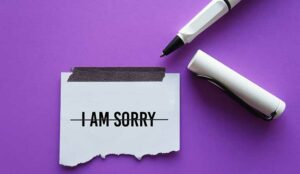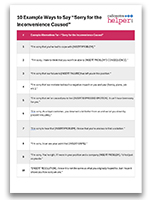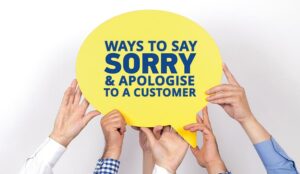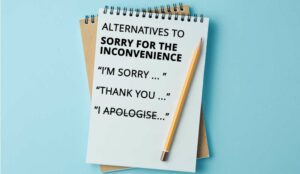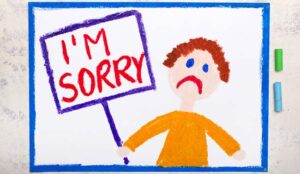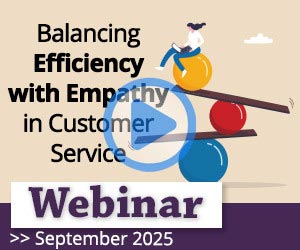Apologies in customer service can either soothe frustration or make matters worse. The phrase “Sorry for all the inconvenience caused” often falls short, lacking sincerity and personalization. A more thoughtful approach can help show genuine empathy, and therefore lead to better resolutions.
In this article, we explore why this common apology misses the mark and provide 10 effective alternatives to use instead.
Why to Avoid ‘Sorry For All the Inconvenience Caused’
The phrase “Sorry for all the inconvenience caused” can often fall flat and fail to address the real concerns of the person you’re apologizing to. It may come across as inadequate or insincere for several important reasons, these include:
- Lack of Personalization
- Lack of Empathy
- Minimal Effort
- Lack of Resolution
- Generic Response
10 Ways to Say ‘Sorry For Any Inconvenience Caused’
Here are 10 template responses to replace this in your contact centre scripts:
1. “I’m Sorry That You’ve Had to Cope With [INSERT PROBLEM].”
Reflecting on the bare bones of the customer’s problem ensures that they feel listened to and understood. Doing so directly after a simple apology statement is often all that is necessary to show acknowledgement and appear apologetic – so long as it pairs with an empathetic tone.
2. “I’m Sorry. I Hate to Think That You Won’t Be Able to [INSERT PROBLEM’S CONSEQUENCE].”
When a problem has a consequence that causes customers stress, advisors can briefly repeat it back to them – within the apology – to show that they comprehend the issue. “I’m sorry, I know that the delay throws off your schedule,” is an example of how this works in practice.
3. “I’m Sorry That Our Failure to [INSERT FAILURE] Has Left You in This Position.”
When the company is at fault, fess up to it. Avoid dancing around the topic. The apology then appears honest and genuine, enabling the advisor to move the conversation along to resolution.
4. “I’m Sorry That Our Mistake Had Such a Negative Impact On You and Your [Family, Plans, Job etc.].”
Again, this statement openly addresses the consequence of the issue. Yet it also demonstrates how an advisor can take ownership by accepting that the company has made a mistake. The use of personal pronouns is a critical part of this.
The advisor says: “I’m sorry that our mistake…” not: “We’re sorry that our mistake…”
5. “I’m Sorry That We’ve Caused You to Feel [INSERT EXPRESSED EMOTION]. It Can’t Have Been Easy For You.”
Mirroring the words customers use builds rapport. Of course, repeating a customer word-for-word is strange, near-impossible in fact, yet mirroring keywords shows that the advisor was listening.
Better still, referencing the emotion they state implies that the advisor understands how they feel. Pair this with the words “I’m sorry”, and this becomes a powerful apology statement.
6. ”I’m Sorry. As a Loyal Customer, You Deserved a Lot Better From Us And We Let You Down By [INSERT FAILURE].”
Many customers will reference that they are long-time customers when making a complaint. Such complaints are threats, which may result in a significant loss of revenue. Taking ownership, acknowledging the failure and apologizing is critical for customer retention.
The phrase above may do just the trick.
7. ”I’m Sorry to Hear That [INSERT PROBLEM]. I Know That You’re Anxious to Find a Solution.”
When a customer is angry, that is a result of anxiety. Therefore, such a statement zeroes in on how they feel, cooling them down in the process.
Uncover more tricks for handling heated customer conversations by reading our article: Rapport Building With Angry Customers – With Examples
8. “I’m Sorry. I Can See Your Point That [INSERT GRIPE].”
By using this phrase, an advisor appears to appreciate the customer’s argument without saying the words: “I understand”. While the phrase “I understand” is often used to convey empathy, customers sometimes feel that the advisor cannot honestly fully understand their situation.
“I’m sorry. I can see your point that…” is a much better example of an empathetic apology.
9. “I’m Sorry. You’re Right. If I Were in Your Position and a Company [INSERT PROBLEM], I’d Feel Just As You Do.”
“You’re right” brings down the temperature of the call. The customer feels justified in their response. The following sentence goes further. It reminds the customer that the advisor is human too, and they can relate to them.
10. “[INSERT RESOLUTION]. I Know it is Not the Same as What You Originally Hoped For, But I Hope it Shows You How Sorry We Are.”
After presenting the call resolution, this apology helps to control the customer’s reaction to the solution. Just be careful not to use and abuse apologies.

Gavin Scott, host of the Customer Service Gold Dust Podcast, warns us that constantly repeating apologies is wasteful.
“The phrase ‘I’m sorry’ is one of your ace cards,” he says. “To make sure it lands, avoid repeating it. Instead of saying words like: ‘I’m sorry for the wait’, thank the customer for their patience.
“Then, when the advisor does say ‘sorry’, it has a much bigger positive impact.”
Printable – 10 Examples of Alternative Ways to Say “Sorry For the Inconvenience Caused”
Do you want to download this to share with your team?
Get your free download of 10 Ways to Say “Sorry for the Inconvenience Caused” now:
Why Specific Apologies Are Better
Both “Sorry for the inconvenience caused” and “Sorry for any inconvenience caused” are a catalyst for customer contempt.

When hearing or reading these phrases, a customer may feel that the advisor doubts whether there has been an inconvenience. Jacqui Turner, founder of Turner Corner Learning Solutions, believes this is often the case.
As an alternative, Jacqui recommends: “Tell the customer that you are sorry and be specific about the reason for your apology – e.g. the damaged item they’ve received, or a delayed payment etc.”
The phrases above will help to do so.
Yet the temptation to use it is sometimes driven by the wish to add a blanket apology to customer service templates.
Even in this scenario, there are better examples, such as “I’m sorry that you had to deal with this.”
Still doubtful about how bad an impact this terrible apology can have? Learn more by checking our article: “Sorry for the Inconvenience” – How to Offer a Genuine Apology
Examples of Non-Apologies
Non-apologies perpetuate a feeling of rejection. They lack sincerity, fanning the flames instead of cooling them down.
This is one example, yet there are many others, including:
- “I’d like to apologize on behalf of [INSERT COMPANY].” – After customers hear this statement, they will think: “Go on then, apologize!”
- “Please accept my sincere apologies for your recent experience.” – It is cold, lacking necessary warmth and specificity to positively impact customer emotion.
- “As a business, we are sorry for this issue.” – In making this statement, the advisor appears to hide behind the business instead of building a personal connection.
Each statement avoids saying the words “I’m sorry” – negating ownership. Sometimes advisors do this deliberately, thinking “Why should I apologize? I have done nothing wrong.”
However, Gavin Scott reminds us: “When taking customer calls, you are the face of the brand. Even if it wasn’t your mistake, you still have to own that response. That is why you must directly say: ‘I’m sorry’.”
With that said, “I’m sorry” can also – at times – come across poorly. There are vague apologies with the word “inconvenience”, yet another terrible example is “I’m sorry you feel that way.”
Such an apology seems to cast doubt over whether the emotions that the customer is experiencing are justified. It breaks rapport.
Follow Up Apologies With an Action
The recommended apology statements acknowledge the issue and help to bring the customer back on-side. Now, avoid dwelling on the negative. Immediately follow up the apology by introducing some next steps.
To do so, continue the apology statement with a bridge to a resolution. For example, an advisor could say:
- “Let’s see what we can do to find a resolution.”
- “Rest assured, I’m going to do all I can to help you resolve the matter.”
- “We will sort this out.”
The last example offers a commitment, which helps to reassure particularly anxious customers. Quick warning: only say this when a resolution is beyond doubt. Otherwise, the advisor risks setting unrealistic expectations.
The lesson here is to mould the apology statement and action to the situation. Once advisors get a handle on saying the words “I’m sorry”, acknowledging the issue and then focusing on the action, this will become second nature.
If you want to explore more call handling hacks, read these articles next:
- “Sorry for the Inconvenience” – How to Offer a Genuine Apology
- How to Handle Call Escalations
- How to Deal With a Customer Who Can’t Stop Talking
- Dealing With Vulnerable Customers
Author: Jonty Pearce
Reviewed by: Hannah Swankie
Published On: 10th Oct 2022 - Last modified: 21st Oct 2025
Read more about - Customer Service Strategy, Apologies, Editor's Picks, Empathy, Free Downloads, Gavin Scott, Handling Customers, Jacqui Turner, Language, Rapport, Service Strategy





